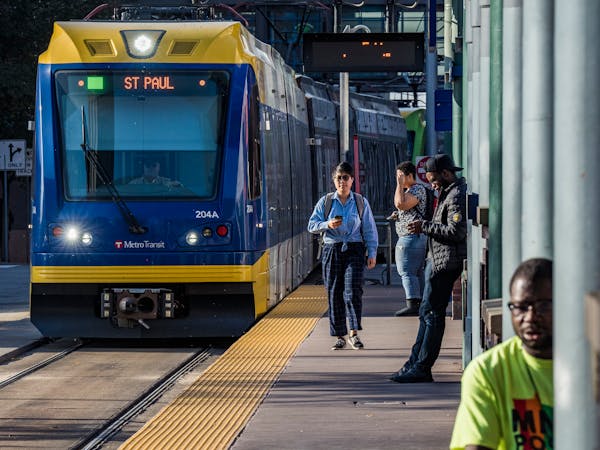Consider the diverse locations, neighborhoods and people that the proposed E Line arterial bus-rapid transit line will serve once it begins operating in 2025.
On its south end, the route will begin at the Southdale Transit Center and head north along France Avenue, over to Uptown and then downtown Minneapolis, into Northeast and the University of Minnesota, and finally on to the Green Line's Westgate Station near Hwy. 280.
The $68 million E Line will be the Twin Cities' fifth arterial bus-rapid transit (BRT) line, largely replacing the busy Route 6 bus line, a workhorse within the Metro Transit system. Construction on the E Line, which is funded with federal, state and local money, will begin next year.
"Route 6 is historically one of our highest-ridership local routes in our system," said Metro Transit's E Line Project Manager Adam Smith in an interview. "It serves a lot of important destinations throughout the corridor, plus growing areas within the region."
The E Line will cater not only to commuters but also to shoppers, students and people seeking medical care (M Health Fairview Southdale Hospital and the U's medical complex), along with theatergoers in Edina and St. Anthony Main, crowds attending the live venues along Hennepin Avenue and sports fans at the U.
The route will touch well-heeled neighborhoods, such as Linden Hills and 50th and France, and fast-growing ZIP codes in southeast Minneapolis and near Prospect Park.
Arterial bus-rapid transit is roughly 20% faster than regular bus service, in part because passengers pay before boarding, and there are two entrances to hop aboard — reducing long queues as people fumble for their fare.
Drivers have signal priority at busy intersections, and the stops are more spread out (every fourth of a mile in the E Line's case) than regular bus routes.
Unlike traditional BRT buses, arterial buses generally operate in traffic, though the E Line will travel in dedicated lanes in Uptown and northeast Minneapolis.
Devan Blanchard, who lives in southeast Minneapolis, said he's been waiting for upgraded bus service on the Route 6 corridor since 2016. "It has taken far too long to just improve some bus stops and add some service," he said. "A child could have been born and will be in the second grade by the time we get it. But other than that, it will be a great improvement."
Metro Transit is known nationally for its successful rollout of arterial bus-rapid service, beginning with the A Line in 2016. The B Line, planned for the Lake Street/Marshall Avenue corridor in Minneapolis and St. Paul, is currently under construction with service slated to begin next year.
Smith said arterial BRT service retains existing passengers but also tends to attract new ones as well.
"It underscores one of the big things we're seeing as an agency as we recover from the pandemic," that people use transit throughout the day and for a variety of purposes, Smith said. "It goes beyond traditional ridership."
A data-driven approach
That's not to say the E Line has been free of controversy. The route along Hennepin Avenue in Uptown has drawn detractors, particularly among minority-owned businesses that fear the loss of street parking.
Metro Transit and Minneapolis officials ultimately agreed to operate priority lanes along that stretch where they're "needed most," according to the city's Hennepin Avenue reconstruction plan.
Hours for the bus-only lanes "will be based on a data-driven approach" when demand is the greatest, city spokesperson Sarah McKenzie said in an email. The plan states that "parking opportunities" will be provided to support businesses.
Concerns about station design and traffic flow also surfaced over the E Line stop at 50th Street and France Avenue in Edina.
The 50th and France Business and Professional Association has asked that the station be moved to 51st and France, a request that appears to have little traction with Metro Transit. If that doesn't happen, the association requested that the station be customized to reflect "the retail nature of the site" and that existing landscaping and pedestrian amenities be restored.
"The prioritization of mass transit over all other modes seems to hinder travel by drivers, delivery vehicles, pedestrians and bicyclists," the association stated in a May 22 letter to the Metropolitan Council.
Other realities will challenge the E Line, including a bus driver shortage that has hindered restoration and expansion of transit service following the COVID-19 pandemic. Whether the dearth of drivers will affect the all-day, 10-minute service provided by the E Line remains to be seen.
The longstanding goal of converting the Metro Transit bus fleet to electric vehicles doesn't appear to be in the offing for the E Line. Spokesman John Komarek said the current range and reliability for charging don't make electric buses "a good fit."
That means E Line buses will operate using biodiesel fuel, at least until zero-emission buses can operate efficiently along heavily used transit corridors.
Carolyn Parnell, 'trailblazer' who served as Minnesota's first IT commissioner, dies


